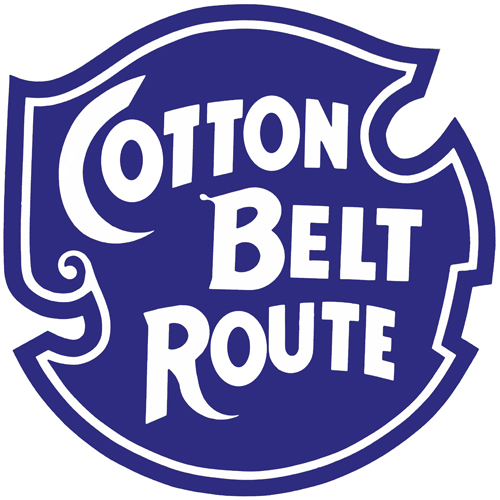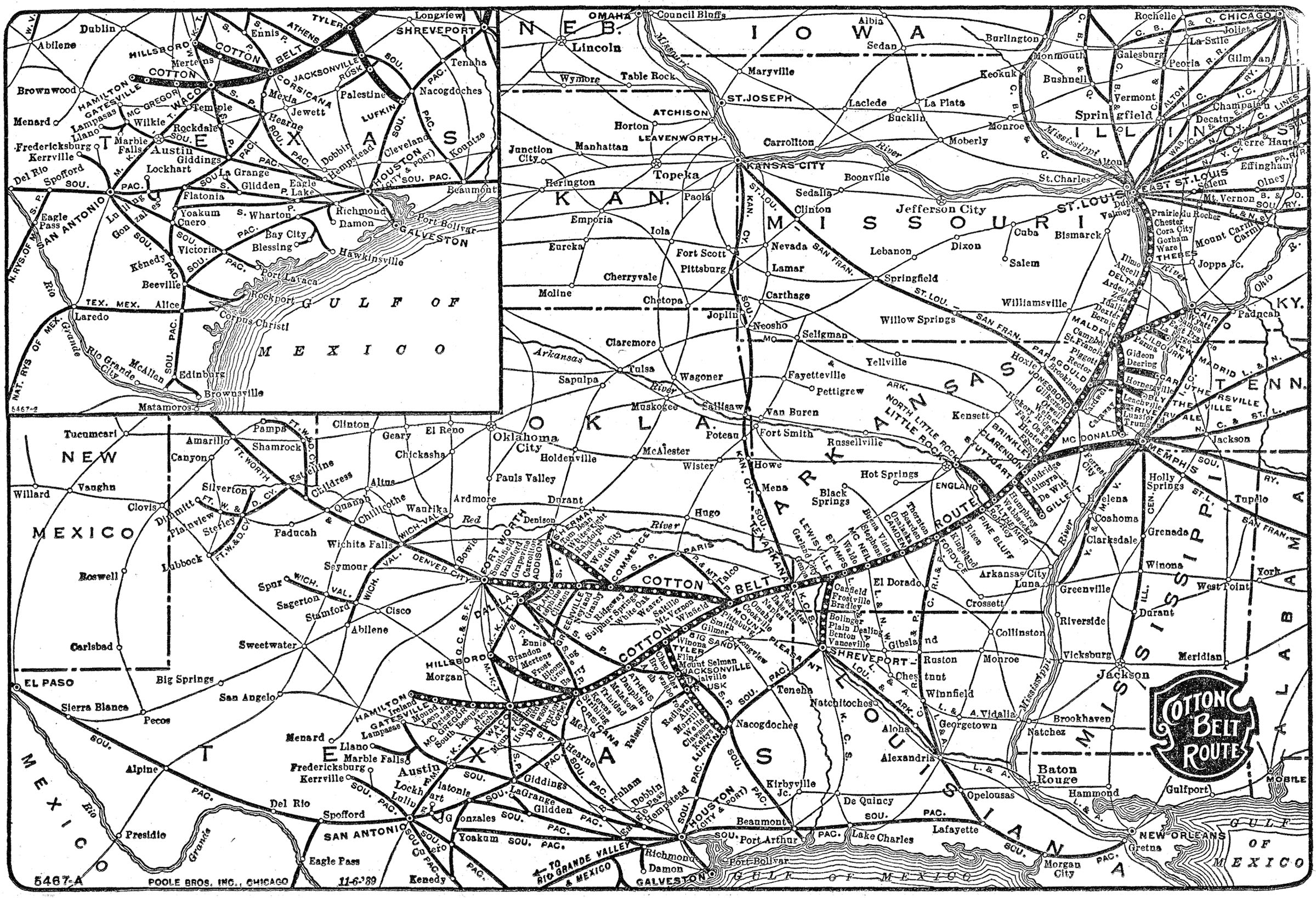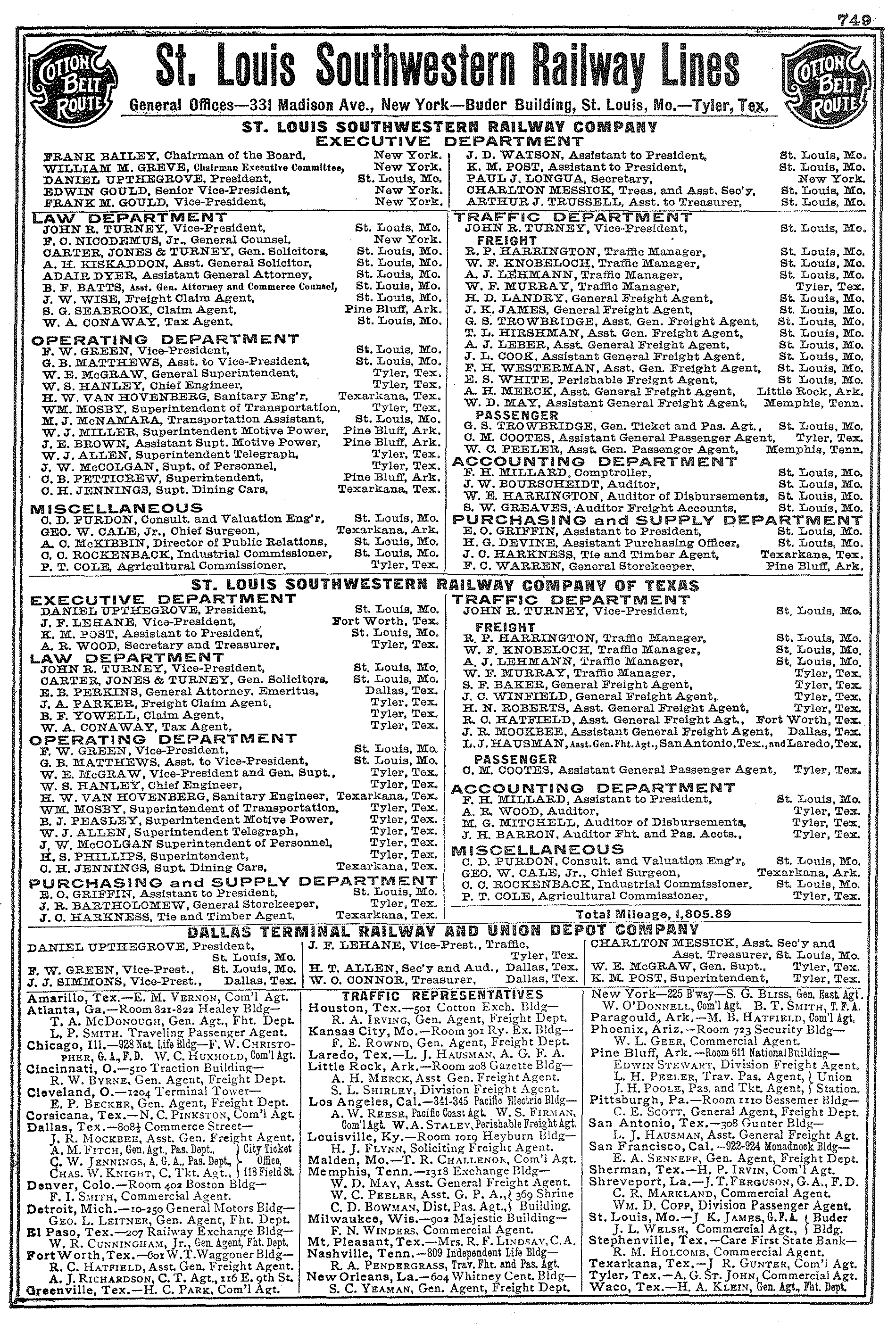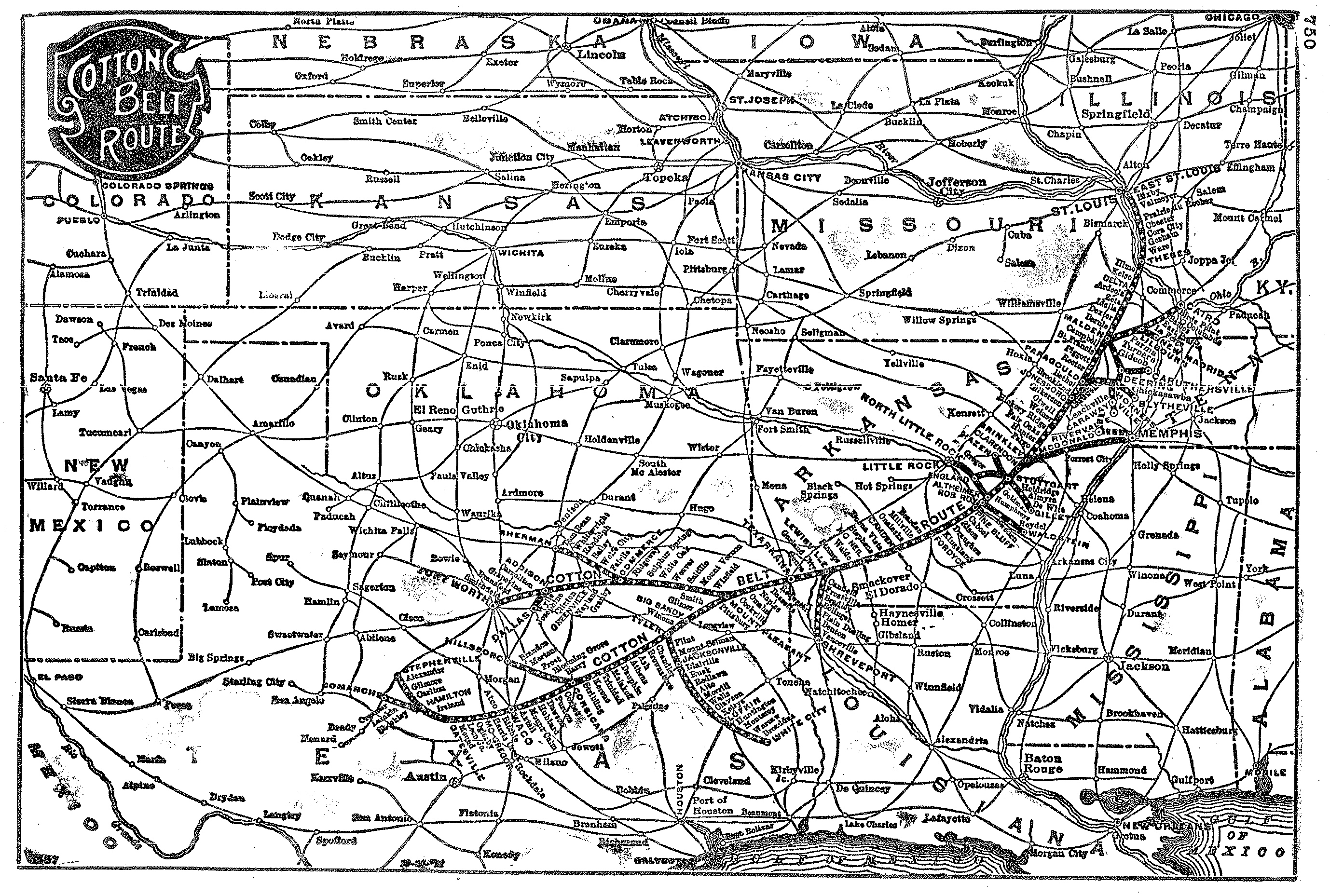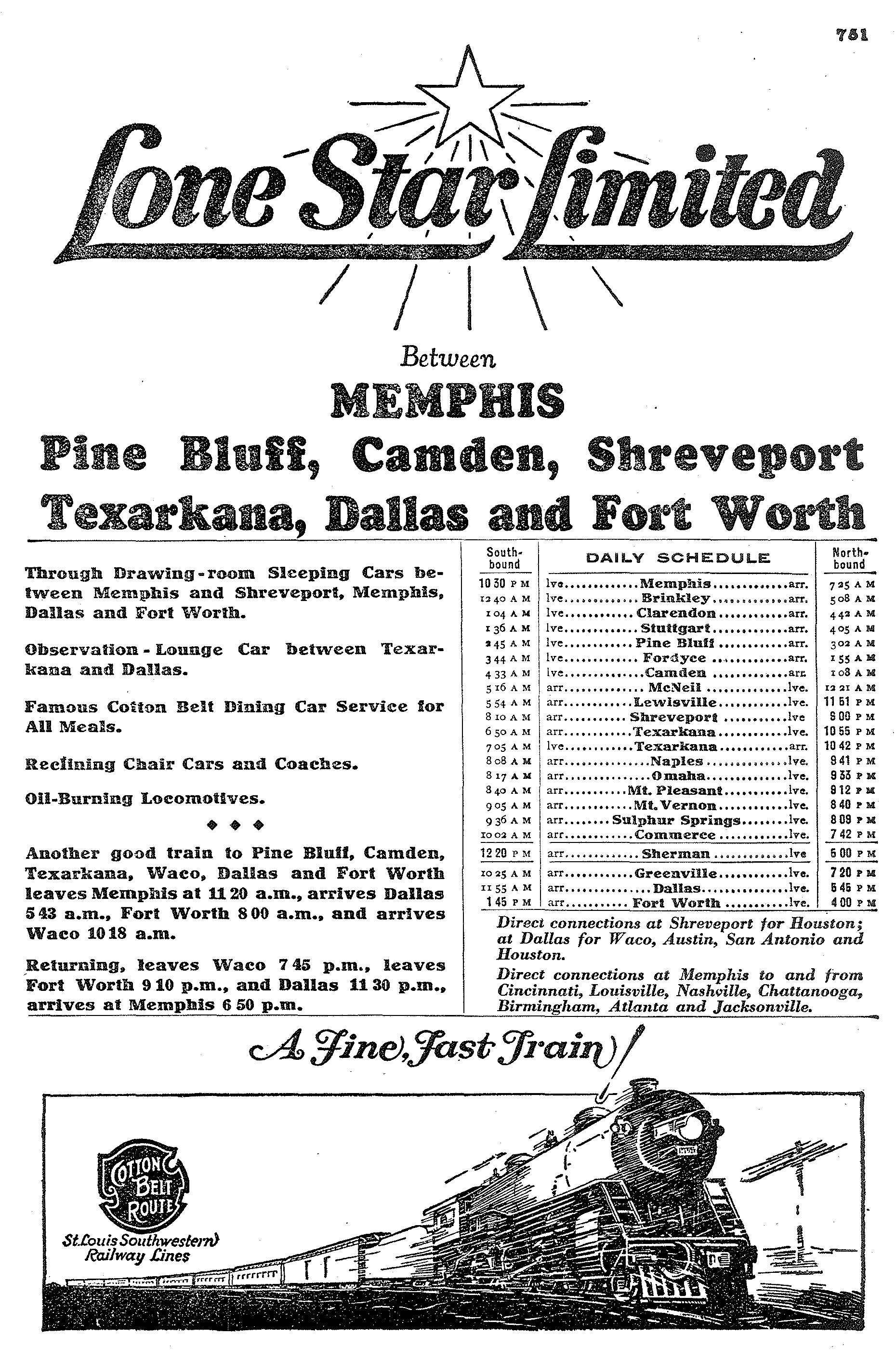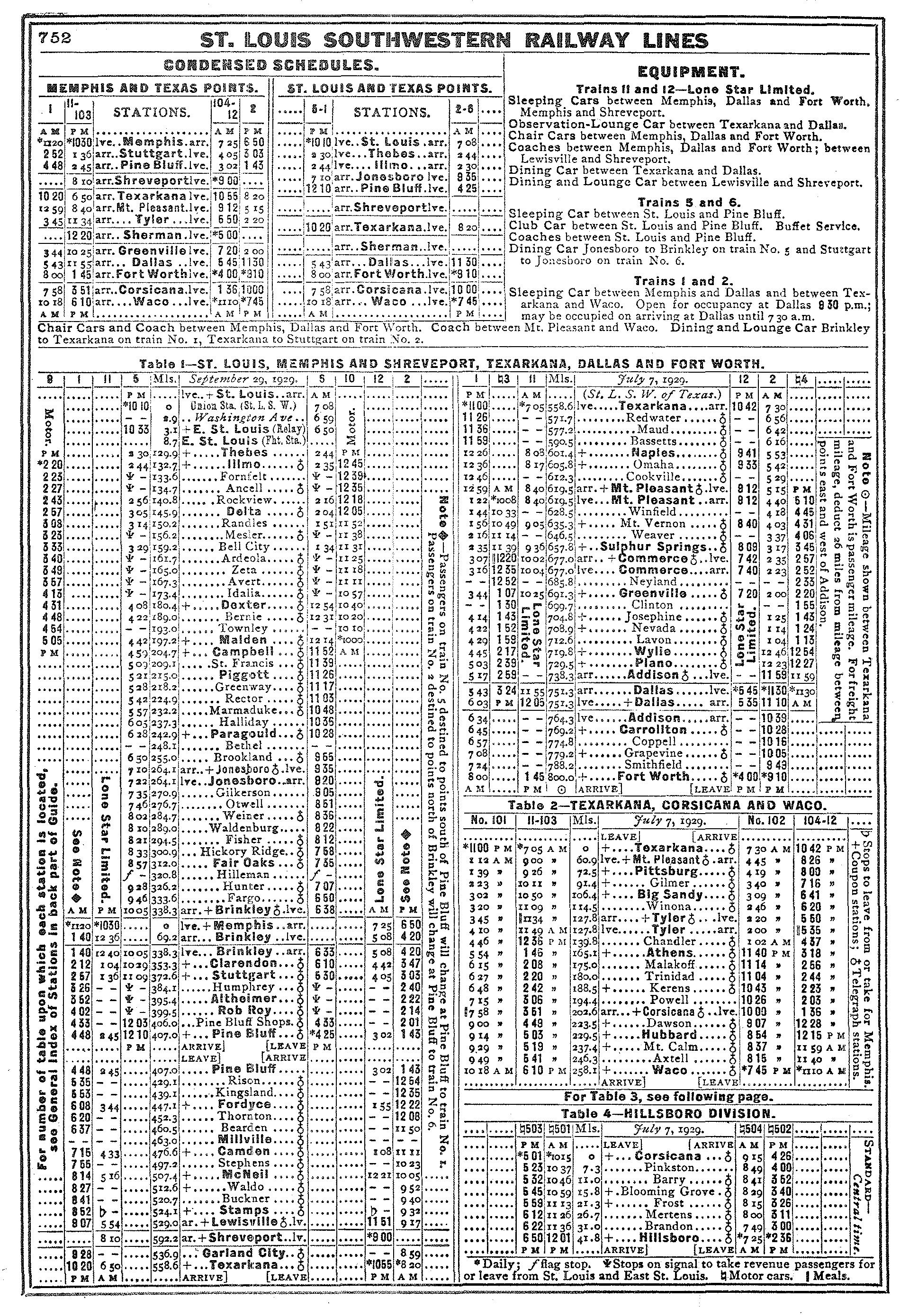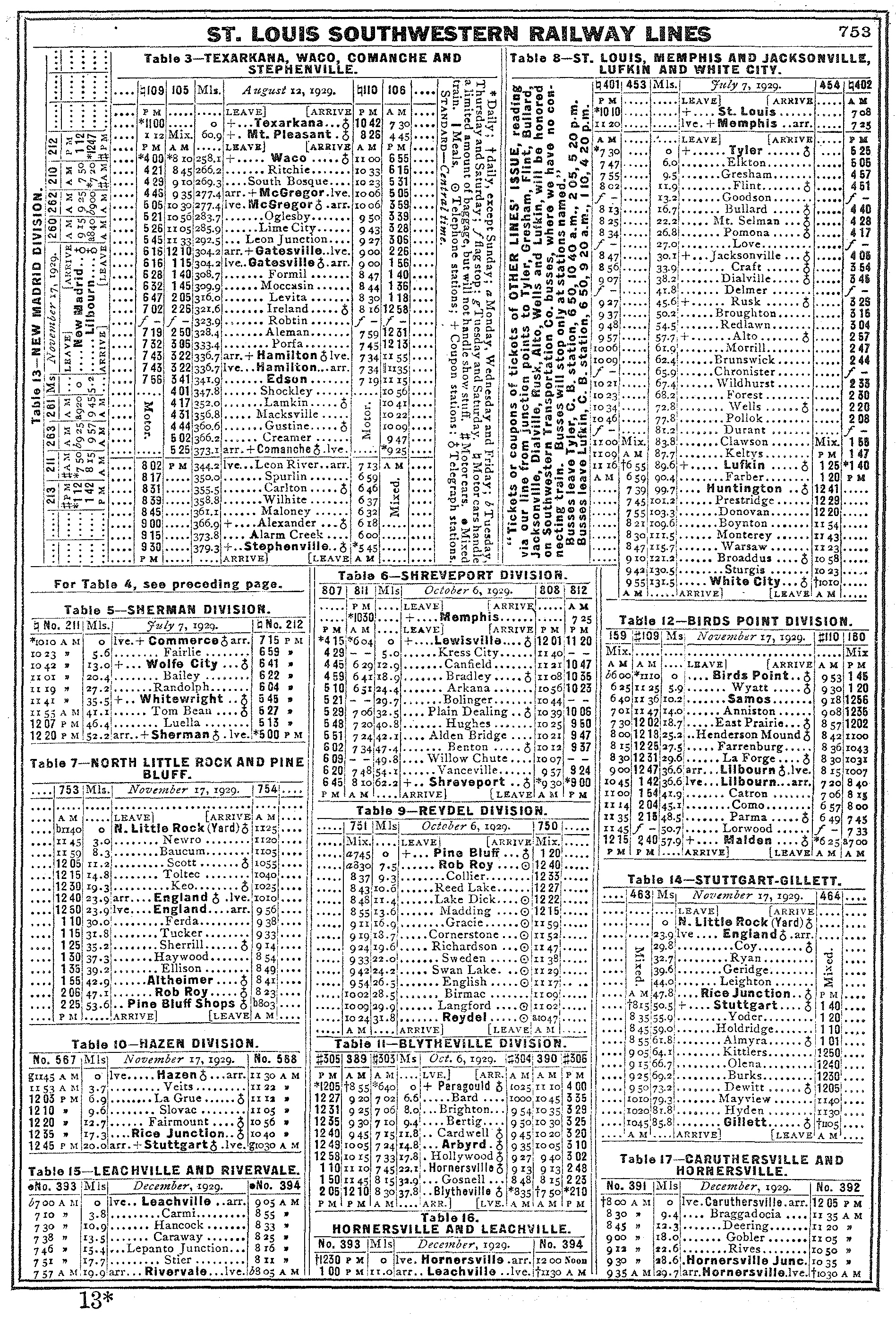St. Louis Southwestern Railway, "The Cotton Belt Route"
Last revised: October 13, 2024
By: Adam Burns
The St. Louis Southwestern Railway is best remembered as an important Southern Pacific subsidiary. However, its formative years carried no SP ties.
It was conceived to provide Tyler, Texas with rail service just after the Civil War and in time blossomed into a respectable 725-mile narrow-gauge system connecting Bird's Point (Wyatt), Missouri with Gatesville, Texas.
According to Dr. George Hilton's book, "American Narrow Gauge Railroads," its 3-foot network was the second-longest in the country, eclipsed only by the Denver & Rio Grande.
It colloquially became known as the "Cotton Belt Route" after St. Louis interests utilized it as an outlet for cotton shipments between Texas and the Gateway City.
Its early years were fraught with financial difficulty but the modern railroad was generally profitable. It became the St. Louis Southwestern in the early 1890's and then went through a series of owners before Southern Pacific gained control during the 1930's.
It thrived at this time as a through route between St. Louis - Texas and still plays an important role under Union Pacific today.
Photos
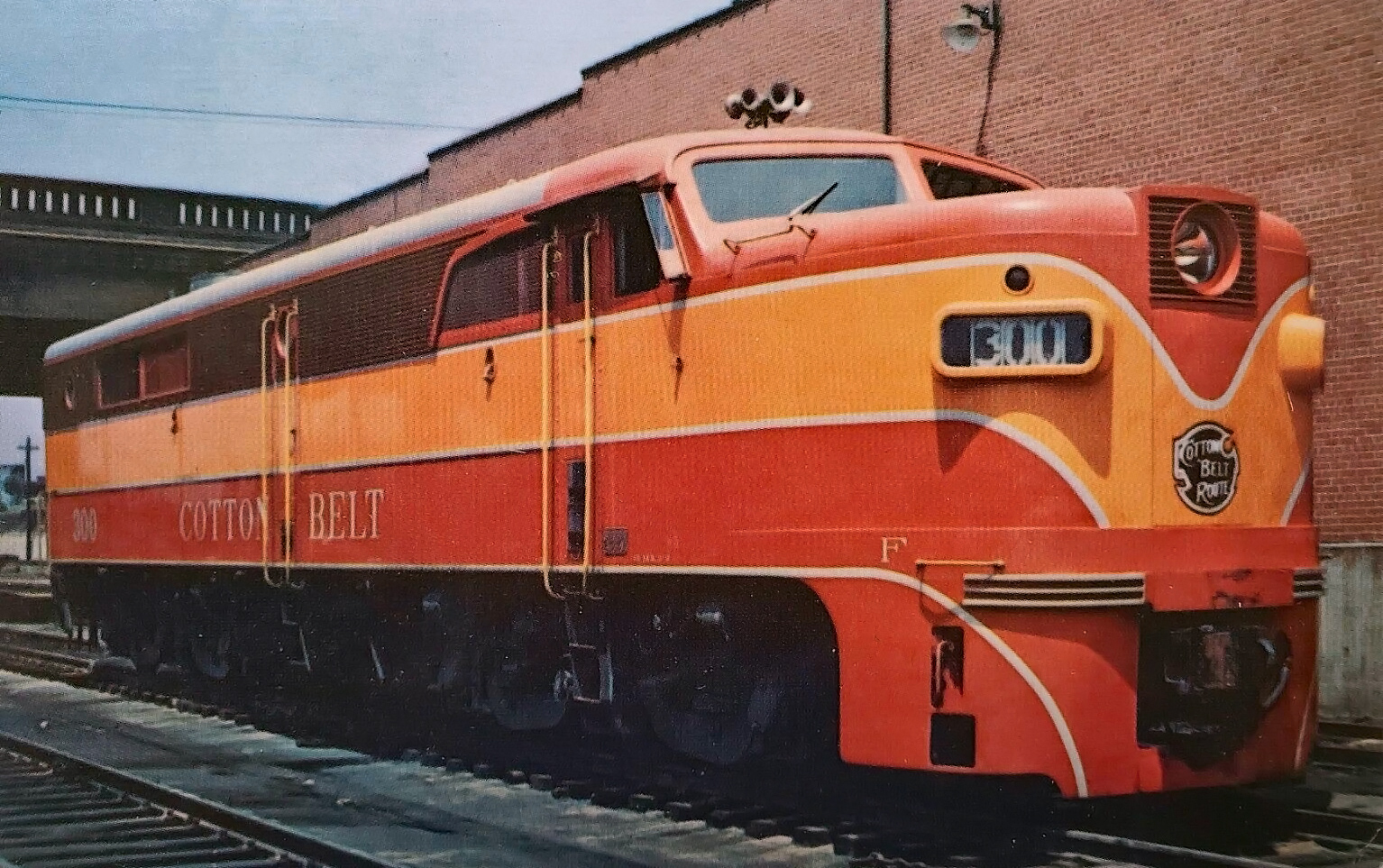 St. Louis Southwestern Railway (Cotton Belt) PA-1 #300 is seen here at the shops in St. Louis, Missouri wearing Southern Pacific's handsome "Daylight" livery on June 6, 1957. Richard Wallin photo.
St. Louis Southwestern Railway (Cotton Belt) PA-1 #300 is seen here at the shops in St. Louis, Missouri wearing Southern Pacific's handsome "Daylight" livery on June 6, 1957. Richard Wallin photo.History
The St. Louis Southwestern Railway is often mentioned in publications or historical texts although it is not always clear what this company was or where it operated. It spent most of the 20th century controlled by another carrier; first, as part of the Gould empire and then later under the Rock Island.
Things remained this way until Southern Pacific purchased the property. In 1947 Cotton Belt's public relations department released a compact but comprehensive booklet detailing its corporate heritage. It was entitled, "A Shorty History Of The St. Louis Southwestern Railway Lines," written by Jacob E. Anderson.
What was transformed into a successful, 1,554-mile Class I railroad ("In Its Race With The Mop's Red Balls, Cotton Belt Goes Like A Blue Streak," by Steve Patterson, from the November, 1962 issue of Trains Magazine) did not begin as such.
It all started as a local community's dream to connect with the outside world. After the citizens of Tyler, Texas realized the International Railroad would not reach their town they took it upon themselves to build their own.
Logo
The Tyler Tap Railroad was granted incorporation by the state legislature on December 1, 1871 for the:
"...right to locate, construct, own, operate, and maintain a railroad, with a single or double track, from Tyler to such a point, not exceeding forty miles from the above town on either the Southern Pacific, Houston and Great Northern or the International Railroad, as may be selected by the directors."
It was led by the town's mayor, Major James P. Douglas, and originally capitalized at $1 million. Less than two years later, on May 7, 1873, the act was amended to increase capitalization to $3 million and the route was changed to, "...run north from Tyler by way of Gilmer, Pittsburg, Mt. Pleasant, and Clarksville to some point on the Red River."
The state provided further aid by granting a 200 foot right-of-way and a five-mile swath for the procurement of construction materials (lumber, dirt, gravel, etc.).
A completion date of May, 1875 was set for the first twenty miles at which point the railroad would be given further support through land grants totaling 640 acres for every completed mile.
Unfortunately, delays were immediate as financing never materialized. This issue caused promoters to abandon the original standard-gauge plan and, instead, would build the Tyler Tap as a three-foot, narrow-gauge.
Expansion
Actual work did not begin until the summer of 1875 with the first 11.1 miles opened by October 3, 1877. It was soon extended to Ferguson, a distance of 21.5 miles. The little pike only operated for two years before it was clear the 190,720 acres in land grants and attempts at local subscription would not be enough to reach the Red River.
So, Douglas and his associates went to St. Louis in the hopes of securing greater financing. There, they met Colonel James W. Paramore who owned the successful St. Louis Cotton Compress Company. He saw great potential in the railroad's ability to handle large volumes of cotton for his business between Texas and St. Louis.
This gave rise to its nickname, the "Cotton Belt Route," a moniker which persevered through the modern era.
After the colonel got involved, eventually ascending to the presidency in May of 1880 (Douglas would ultimately leave the company for other pursuits, going on to build the Kansas & Gulf Short Line which, ironically, also became part of the modern Cotton Belt.), the Tyler Tap was reincorporated as the Texas & St. Louis Railway (T&StL) on May 14, 1879.
He was successful in securing financial support from the New York investment bankers Kuhn, Loeb & Company.
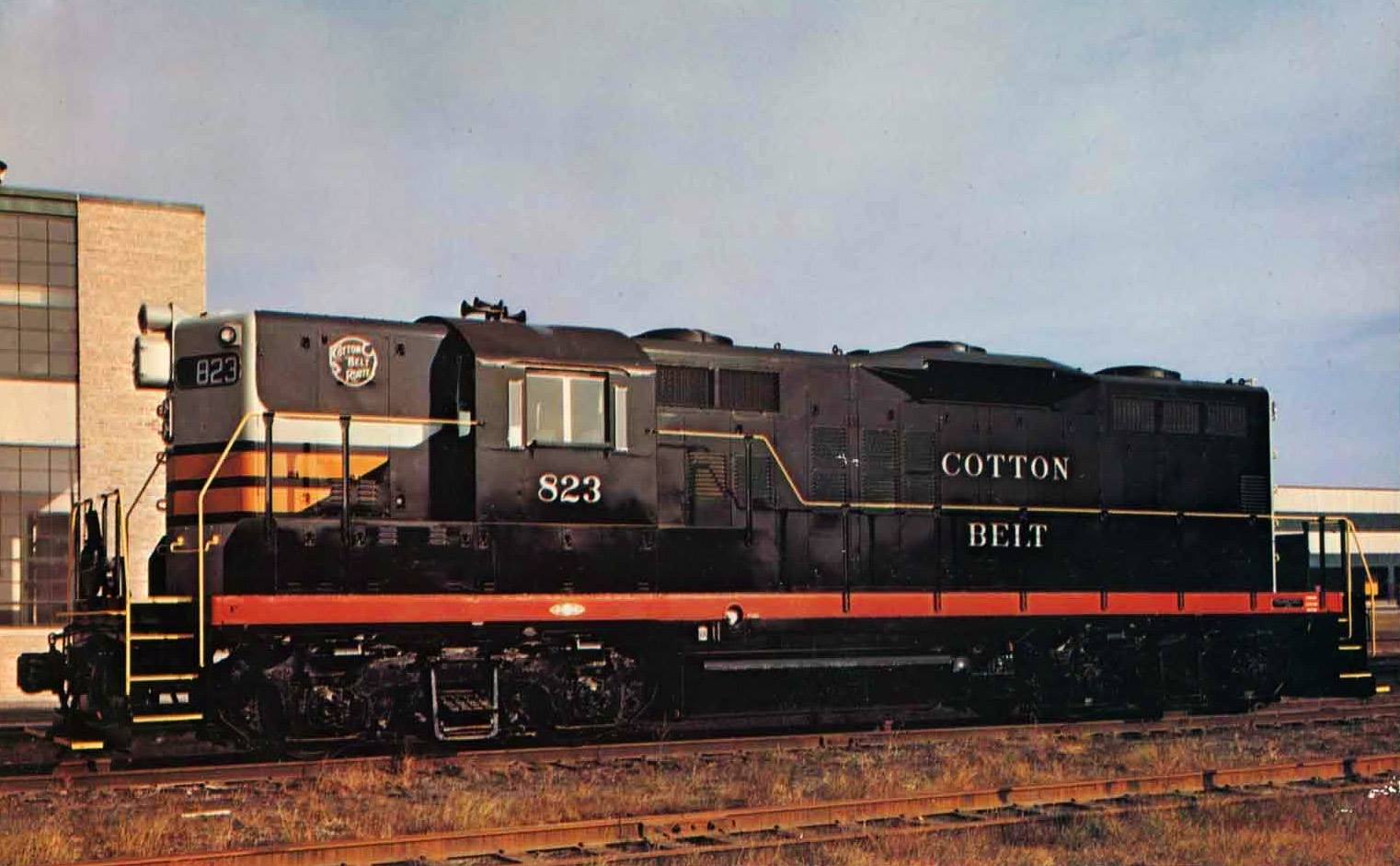 An Electro-Motive builder's photo featuring freshly outshopped St. Louis Southwestern (Cotton Belt) GP9 #823 during October of 1957 wearing parent Southern Pacific's "Black Widow" livery.
An Electro-Motive builder's photo featuring freshly outshopped St. Louis Southwestern (Cotton Belt) GP9 #823 during October of 1957 wearing parent Southern Pacific's "Black Widow" livery.Paramore became an able and ardent railroader who even went toe-to-toe against the powerful Jay Gould. At first, he sought to build the T&StL from Texarkana to Waco and would utilize the St. Louis, Iron Mountain & Southern (StLIM&S) to reach St. Louis.
Construction commenced quickly and by July 5, 1880 had opened to Texarkana. In December rails were pushed as far west as Trinity with the expectation of completing the corridor by sometime in 1881. While this was under way, Gould gained control of the StLIM&S and immediately ended the through traffic agreement.
Typical of the tycoon's schemes, he attempted to choke off T&StL's traffic and force Paramore to either sell out or capitulate. This tactic usually worked but Gould found a true fighter in the colonel who countered by announcing an extension not only towards St. Louis but also the Mexican border at either Laredo or Eagle Pass.
There, the T&StL would interchange with the William Palmer's and James Sullivan's syndicate working on a route into Mexico City (Mexican National Railway and Texas-Mexican Railway). Paramore's line towards St. Louis would terminate at Bird's Point, Missouri, located just south of, and directly across the Mississippi River from, Cairo, Illinois.
Here, an interchange would be established with the narrow-gauge Cairo & St. Louis (a future component of the Gulf, Mobile & Ohio) for through service into St. Louis.
System Map (1939)
With $4 million in bonds available, he wasted no time extending his railroad in both directions. Much of the growth was accomplished through new construction except for the May, 1881 acquisition of the small Little River & Arkansas Valley Railroad which operated 27 miles between New Madrid and Malden, Missouri.
During a grand ceremony held on August 12, 1883 Colonel Paramore drove a silver spike on the new bridge spanning the Arkansas River at tiny Rob Roy, Arkansas which signaled the railroad's completion between Gatesville, Texas and Bird's Point, Missouri via Waco, Texarkana, Pine Bluff, and Malden.
In a strange turn of events, the Cairo & St. Louis showed no interest in working with the T&StL. As a result, Paramore instead worked out an agreement with the standard-gauge Cairo Short Line Railroad, an Illinois Central subsidiary, to reach St. Louis.
The two mitigated the gauge difference by laying third-rail within the car ferries as well as at IC's terminal trackage in Cairo.
Following its opening the T&StL immediately ran into trouble as lack of adequate equipment caused traffic delays. This was further expounded by heavy rains during the fall of 1883. Unable to pay its employees, T&StL train crews went out on strike that November.
Overview
3 Feet (October 3, 1877 - January 12, 1887) 4 Feet, 8 ½ Inches (January 13, 1887 - 1992) |
|
Memphis - Brinkley, Arkansas St. Louis - Texarkana - Dallas/Fort Worth Texarkana - Waco Corsicana- Hillsboro, Texas Waco - Stephenville/Comanche, Texas Lewisville, Arkansas - Shreveport, Louisiana (Shreveport Division) Commerce - Sherman, Texas (Sherman Division) North Little Rock - Pine Bluff, Arkansas Hazen - Stuttgart, Arkansas (Hazen Division) Leachville - Rivervale, Arkansas Pine Bluff - Reydel, Arkansas (Reydel Division) Paragould - Blytheville, Arkansas (Blytheville Division) Hornersville - Leachville, Arkansas Stuttgart - Gillett, Arkansas Caruthersville - Hornersville, Arkansas | |
With no relief in sight the company formally entered receivership on January 23, 1884. Just over a year later, on April 1, 1885, Samuel Fordyce took over for W.R. Woodard as receiver.
He immediately improved the company's well-being by raising revenues, which allowed employees to be paid on-time. Such efforts helped the railroad escape reorganization relatively quickly as it became the St. Louis, Arkansas & Texas Railroad (StLA&T) on May 1, 1886.
Fordyce subsequently achieved the presidency while Paramore's involvement ended. Unfortunately, the colonel was never able to complete his Lardeo extension but had successfully established a true competitor against Gould's dominating presence.
One of Fordyce's first tasks was to standard-gauge the property as a means of improving efficiency and interchange. The first section, from Bird's Point to Texarkana, a record 419 miles, was completed in a single day on October 18, 1886 with the remaining Texas trackage finished by January 12, 1887.
After the main line was re-gauged the rest of the 19th century focused on expansion across the Southwest. While it never operated a substantial branch line network the Cotton Belt did reach the following points during 1887:
- By acquiring the three-foot Kansas & Gulf Short Line service was extended from Tyler to Lufkin (As previously mentioned, Major James Douglas helped construct this railroad; originally projected to the Gulf of Mexico at Sabine Pass, Texas it was never built beyond Lufkin.)
- Later that same year (July) the StLA&T completed an important link from Mount Pleasant to Fort Worth.
This corridor also included a branch from Commerce to Sherman (Dallas was reached directly in May of 1903 via a short spur from Addison). In 1888 there were three additional extensions to Argenta (Little Rock), Hillsboro, and Shreveport, Louisiana. To improve operations, Fordyce upgraded the infrastructure through the use of heavier rail.
Unfortunately, he soon realized earnings alone could not cover the cost of this project. As an emergency measure he handed over the railroad to Jay Gould but even the powerful tycoon (whose empire was soon handed over to his eldest son, George) could not prevent receivership which occurred on May 13, 1889.
It exited reorganization on June 1, 1891 at which time the new St. Louis Southwestern Railway (incorporated in Texas on January 12, 1891 with incorporation in Missouri occurring a few days later on January 16th) took control. Fordyce remained president for a few years until philosophical differences with the younger Gould caused him to leave the company on October 31, 1898.
He was subsequently replaced by Edwin Gould, another of Jay's sons. Unlike his father, who was hated throughout the industry for his shady and manipulative business practices, Edwin did well at the helm.
That year access into St. Louis was improved by opening an extension from Malden to Grays Point (Illmo), Missouri along the Mississippi River.
From here, car ferry service with the Illinois Central was established (Thebes). Two years later, on October 15, 1900, it worked out an agreement with the St. Louis, Iron Mountain & Southern (Missouri Pacific) for trackage rights directly into St. Louis Union Station.
This event marked the first time the Cotton Belt gained direct entry into the Gateway City and was further enhanced when the Thebes Bridge opened in 1905 (a joint project between the St. Louis Southwestern, Missouri Pacific, Chicago & Eastern Illinois, and St. Louis-San Francisco Railway).
Into the early 20th century the Cotton Belt continued to grow, again through a series of branches: it picked up the bankrupt Stuttgart & Arkansas River Railroad on January 3, 1901 which ran from a connection along the main line at Stuttgart, Arkansas to nearby Gillett; for a time, its western terminus was extended beyond Gatesville to Hamilton by leasing the Stephenville, North & South Texas Railroad on July 1, 1913.
At its peak this system linked Gatesville and Hamilton with spurs reaching Stephenville and Camanche. It was never particularly successful and most of the trackage was abandoned between October of 1934 and January of 1941.
The modern St. Louis Southwestern Railway played an important role in handling both freight and passengers between Texas and the Midwest.
It came under the United States Railroad Administration's control with the onset of World War I, made effective at noon on December 28, 1917. Like most of the industry, it suffered immensely under the government through deferred maintenance and poor management.
Diesel Roster
The American Locomotive Company
| Model Type | Road Number | Date Built | Quantity |
|---|---|---|---|
| RS3 | 308-310 | 4/1952 | 3 |
| RS3 | 311 (1st) | 5/1951 | 1 |
| RS3 | 311 (2nd) | 10/1952 | 1 |
| RS3 | 312-318 | 5/1951-12/1951 | 7 |
| RS3 | 356-360 | 3/1952-10/1952 | 5 |
| RSD5 | 270-272 | 4/1953 | 3 |
| RSD15 | 850-859 | 3/1960 | 10 |
| PA-1 | 300-301 | 11/1949 | 2 |
Baldwin Locomotive Works
| Model Type | Road Number | Date Built | Quantity |
|---|---|---|---|
| DT-6-6-2000 | 260 | 5/28/1948 | 1 |
| VO-1000 | 1000-1022 | 7/20/1942-12/14/1945 | 23 |
| DS-4-4-1000 | 1023-1027 | 12/13/1947-1/4/1948 | 5 |
Electro-Motive Division
| Model Type | Road Number | Date Built | Quantity |
|---|---|---|---|
| GP7 | 320 | 6/1950 | 1 |
| FTA | 900A, 905A, 910A, 915A, 920A, 900D, 905D, 910D, 915D, 920D | 6/1944-6/1945 | 10 |
| FTB | 900B, 905B, 910B, 915B, 920B, 900C, 905C, 910C, 915C, 920C | 6/1944-6/1945 | 10 |
| F7A | 925-975 (Odds) | 2/1950-9/1952 | 26 |
| F7B | 926-958 (Evens) | 2/1950-5/1952 | 16 |
| NW2 | 1050-1053 | 5/1949-11/1949 | 4 |
| SW7 | 1054-1057 | 4/1950 | 4 |
| SW9 | 1058-1061 | 12/1951-1/1952 | 4 |
| SW1200 | 1062-1073 | 1/1964-2/1965 | 12 |
| SW1200 | 2289-2293 | 1/1966-4/1966 | 5 |
| SW1500 | 2481-2492 | 3/1968-6/1968 | 12 |
| SW1500 | 2511-2522 | 3/1969-6/1969 | 12 |
| SW1500 | 2579-2590 | 1/1970-12/1971 | 12 |
| GP9 | 820-831 | 10/1957-2/1959 | 12 |
| GP20 | 800-819 | 12/1960-1/1962 | 20 |
| GP30 | 750-759 | 2/1963 | 10 |
| FP7 | 330 | 4/1950 | 1 |
| GP40-2 | 7248-7273 | 10/1984-11/1984 | 26 |
| GP35 | 760-781 | 1/1964-7/1965 | 22 |
| GP40 | 7600-7607 | 1/1966-3/1966 | 8 |
| GP40-2 | 7628-7657 | 1/1979-2/1979 | 30 |
| SD40T-2 | 8322-8326 | 1/1978 | 5 |
| SD40T-2 | 8372-8376 | 1/1978-2/1978 | 5 |
| SD45 | 8964-8981 | 2/1968-6/1968 | 18 |
| SD45 | 9052-9068 | 12/1968-1/1969 | 17 |
| SD45 | 9152-9155 | 1/1970 | 4 |
| SD45T-2 | 9157-9165 | 7/1972 | 9 |
| SD45T-2 | 9261-9301 | 2/1973-3/1973 | 41 |
| SD45T-2 | 9315-9343 | 1/1974-2/1974 | 29 |
| SD45T-2 | 9371-9404 | 3/1975-6/1975 | 34 |
| GP60 | 9620-9714 | 9/1988-5/1990 | 95 |
Steam Roster
Narrow-Gauge
| Road Number | Name | Wheel Arrangement | Builder | Date Built/Notes |
|---|---|---|---|---|
| 1 | Governor Hubbard | 2-6-0 | National Locomotive | 2/1877 |
| 2 | Judy | 2-4-0 | I.R. Adams | 10/1880 |
| 3 | M.C. Humphrey | 2-6-0 | Brooks | 2/17/1880 |
| 4 | W.M. Senter | 2-6-0 | Brooks | 11/5/1879 |
| 5 | J.W. Paramore | 4-4-0 | Brooks | 7/2/1879 |
| 6 | J.L. Sloss | 2-6-0 | H.K. Porter | 6/1879 |
| 7 | J.P. Douglas | 4-4-0 | H.K. Porter | 6/1879 |
| 8 | J.D. Goldman | 2-6-0 | Grant Locomotive | 11/17/1880 |
| 9 | George D. Fisher | 2-6-0 | Grant Locomotive | 11/17/1880 |
| 10 | W.F. Obear | 2-6-0 | Grant Locomotive | 10/24/1881 |
| 11 | T.H. West | 2-6-0 | Grant Locomotive | 10/24/1881 |
| 12 | J.M. Weaver | 2-6-0 | Grant Locomotive | 11/3/1881 |
| 13 | J.N. Stegall | 2-6-0 | Grant Locomotive | 11/3/1881 |
| 14 | John M. Gilkeson | 2-6-0 | Grant Locomotive | 11/3/1881 |
| 15 | W.T. Wilkins | 2-6-0 | Grant Locomotive | 11/3/1881 |
| 16 | S.E. Bemis | 2-6-0 | Grant Locomotive | 3/16/1882 |
| 17 | N.T. White | 2-6-0 | Grant Locomotive | 3/16/1882 |
| 18 | John Parham | 2-6-0 | Grant Locomotive | 3/16/1882 |
| 19 | T.J. Lowe | 2-6-0 | Grant Locomotive | 3/3/1882 |
| 20 | T.R. Bonner | 2-6-0 | Grant Locomotive | 3/3/1882 |
| 21 | L.C. DeMorse | 2-6-0 | Grant Locomotive | 3/16/1882 |
| 22 | J.W. Brown | 2-6-0 | Grant Locomotive | 3/8/1882 |
| 23 | Isaac Lees | 2-6-0 | Grant Locomotive | 3/3/1882 |
| 24 | A.M. Shead | 2-6-0 | Grant Locomotive | 6/2/1882 |
| 25 | T.C. Culberhouse | 2-6-0 | Grant Locomotive | 6/3/1882 |
| 26 | A.M. Davis | 2-6-0 | Grant Locomotive | 6/6/1882 |
| 27 | J.B. Fisher | 2-6-0 | Grant Locomotive | 6/8/1882 |
| 28 | L.D. Kingsland | 2-6-0 | Grant Locomotive | 6/10/1882 |
| 29 | William Cameron | 2-6-0 | Grant Locomotive | 6/10/1882 |
| 30 | John Halliday | 2-8-0 | Grant Locomotive | 6/16/1882 |
| 31 | Thompson Bird | 2-8-0 | Grant Locomotive | 6/16/1882 |
| 32 | C.M. Donaldson | 4-4-0 | Grant Locomotive | 8/5/1882 |
| 33 | George M. Dilley | 4-4-0 | Grant Locomotive | 8/5/1882 |
| 34 | L.B. Fish | 4-4-0 | Grant Locomotive | 8/6/1882 |
| 35 | A.L. Horner | 4-4-0 | Grant Locomotive | 8/7/1882 |
| 36 | H.G. Askew | 4-4-0 | Grant Locomotive | 8/9/1882 |
| 37 | C.M. Seeley | 4-4-0 | Grant Locomotive | 8/12/1882 |
| 38 | R.B. Wright | 4-4-0 | Grant Locomotive | 8/14/1882 |
| 39 | S.W. Fordyce | 4-4-0 | Grant Locomotive | 8/15/1882 |
| 40 | C.F. Stephens | 4-4-0 | Grant Locomotive | 8/18/1882 |
| 41 | S.T. Emerson | 4-4-0 | Grant Locomotive | 8/19/1882 |
| 42 | F.W. Paramore | 4-4-0 | Grant Locomotive | 8/22/1882 |
| 43 | Jacob. H. Schiff | 4-4-0 | Grant Locomotive | 8/24/1882 |
| 44 | C.T. Bonner | 4-4-0 | Grant Locomotive | 8/26/1882 |
| 45 | W.C. Douglass | 4-4-0 | Grant Locomotive | 8/28/1882 |
| 46 | Thomas E. Tutt | 4-4-0 | Grant Locomotive | 8/31/1882 |
| 47 | George B. Hubbard | 4-4-0 | Grant Locomotive | 11/19/1882 |
| 48 | R.C. Kerens | 4-4-0 | Grant Locomotive | 11/21/1882 |
| 49 | W.L. Black | 4-4-0 | Grant Locomotive | 11/23/1882 |
| 50 | Wiley Jones | 4-4-0 | Grant Locomotive | 11/24/1882 |
| 51 | A.W. Soper | 4-4-0 | Grant Locomotive | 12/3/1882 |
| 52 | George W. Brown | 2-6-0 | Grant Locomotive | 10/12/1882 |
| 53 | George Bain | 2-6-0 | Grant Locomotive | 10/14/1882 |
| 54 | N.G. Larimore | 2-6-0 | Grant Locomotive | 10/15/1882 |
| 55 | J.B. Kehlor | 2-6-0 | Grant Locomotive | 10/16/1882 |
| 56 | O.B. Filley | 2-6-0 | Grant Locomotive | 10/19/1882 |
| 57 | E.O. Stanard | 2-6-0 | Grant Locomotive | 10/21/1882 |
| 58 | W.A. Hagadine | 2-6-0 | Grant Locomotive | 10/23/1882 |
| 59 | Samuel Cupples | 2-6-0 | Grant Locomotive | 10/24/1882 |
| 60 | E.C. Simmons | 2-6-0 | Grant Locomotive | 10/27/1882 |
| 61 | S.M. Dodd | 2-6-0 | Grant Locomotive | 10/29/1882 |
| 62 | W.J. Lemp | 2-6-0 | Grant Locomotive | 10/30/1882 |
| 63 | Adolphus Busch | 2-6-0 | Grant Locomotive | 10/31/1882 |
| 64 | William H. Waters | 2-6-0 | Grant Locomotive | 11/10/1882 |
| 65 | Miles Sells | 2-6-0 | Grant Locomotive | 12/12/1883 |
| 66 | C.H. Allen | 2-6-0 | Grant Locomotive | 12/12/1883 |
| 67 | J.H. Draughan | 2-6-0 | Grant Locomotive | 12/10/1883 |
| 68 | A.H. Chandler | 2-6-0 | Grant Locomotive | 12/10/1883 |
| 69 | John Talbot | 2-6-0 | Grant Locomotive | 12/14/1883 |
| 70 | W.B. McNeil | 2-6-0 | Grant Locomotive | 12/14/1883 |
| 71 | C.L. Sharman | 2-6-0 | Grant Locomotive | 12/15/1883 |
| 72 | J.M. Kelso | 2-6-0 | Grant Locomotive | 12/15/1883 |
| 73 | - | 2-6-0 | Grant Locomotive | 12/20/1883 |
| 74 | T.F. Murchison | 2-6-0 | Grant Locomotive | 1/13/1884 |
| 75 | J.V. Lewis | 2-6-0 | Rhode Island | 4/21/1884 |
| 76 | R.S. Brookings | 2-6-0 | Rhode Island | 4/21/1884 |
| 77 | A.C. Pierce | 2-6-0 | Rhode Island | 4/21/1884 |
| 78 | C. Kahn | 2-6-0 | Rhode Island | 4/21/1884 |
| 79 | E.F. Walker | 2-6-0 | Rhode Island | 6/12/1884 |
| 80 | C.O. Godfrey | 2-6-0 | Rhode Island | 4/25/1884 |
| 81 | E.D. True | 2-6-0 | Rhode Island | 6/12/1884 |
| 82 | John Krauss | 2-6-0 | Rhode Island | 6/12/1884 |
| 83 | Horace Tucker | 2-6-0 | Rhode Island | 6/12/1884 |
| 84 | O.G. Murray | 2-6-0 | Rhode Island | 6/12/1884 |
Standard-Gauge
| Road Number(s) | Class | Wheel Arrangement | Builder | Date Built/Notes |
|---|---|---|---|---|
| 7 | E-1 | 2-8-0 | Baldwin | 1/1889* |
| 8 | A-1 | 4-6-0 | Baldwin | 11/1920** |
| 9 | - | 4-4-0 | Schenectady | 3/1880** |
| 12/412 | D-1 | 2-6-0 | Baldwin | 8/1915* |
| 40-46 | C-2 | 4-4-0 | Rogers | 6/1900-8/1900 |
| 47-51 | C-2 | 4-4-0 | Alco/Pittsburgh | 5/1901 |
| 52-57 | C-2 | 4-4-0 | Alco/Rogers | 4/1903 |
| 58-62 | D-1 | 4-4-0 | Baldwin | 11/1906 |
| 86-87*** | C-4 | 0-6-0 | Alco/Rogers | 2/1903 |
| 88-92 | C-4 | 0-6-0 | Alco/Rogers | 1/1903-2/1903 |
| 93-94 | C-4 | 0-6-0 | Alco/Pittsburgh | 7/1901 |
| 95-97 | C-3 | 0-6-0 | Pine Bluff Shops | 9/1895-8/1900 |
| 98-99 | B-1 | 4-4-0 | Dickson | 2/1887 |
| 100-114 | A-1 | 4-4-0 | Dickson | 10/1886-3/1887 |
| 115-138 | B-1 | 4-4-0 | Rome | 9/1886-10/1886 |
| 139-144 | B-3 | 4-6-0 | Rome | 11/1886 |
| 145-150,152-162 (1st) | B-2 | 4-4-0 | Galion Shops | 1/1880-4/1883**** |
| 151,163-168 (1st) | B-2 | 4-4-0 | Meadville Shops | 6/1880-12/1883**** |
| 169 | B-2 | 4-4-0 | Meadville Shops | 9/1881 |
| 145-168 (2nd) | C-1 | 4-4-0 | Pine Bluff Shops | 12/1894-9/1899**** |
| 170-196 | C-1 | 2-6-0 | Rhode Island | 9/1887-11/1888 |
| 197-199 | D-2 | 2-6-0 | Rome | 12/1888 |
| 200-205 | D-2 | 4-6-0 | Richmond | 8/1898-9/1898 |
| 206-208 | E-2 | 4-6-0 | Rogers | 11/1899 |
| 209-214 | E-2 | 4-6-0 | Rogers | 10/1900-11/1900 |
| 215-224 | F-1 | 4-6-0 | Alco/Pittsburgh | 6/1901-7/1901 |
| 250-255 | D-2 | 4-6-0 | Baldwin | 6/1910 |
| 300-330 | D-3 | 2-6-0 | Rogers | 12/1901-4/1904 |
| 331-340 | E-3 | 2-6-0 | Baldwin | 11/1906-3/1909 |
| 400-404 | G-1 | 2-6-0 | Alco/Rogers | 4/1905 |
| 425-428 | E-4 | 2-6-0 | Baldwin | 9/1912 |
| 450-459 | G-1 | 2-6-0 | Baldwin | 3/1909 |
| 500-509 | G-2 | 2-8-0 | Baldwin | 11/1906 |
| 510-529 | G-2 | 2-8-0 | Baldwin | 2/1909-7/1910 |
| 500, 504, 509, 524, 528 | G-1 | 0-8-0 | Pine Bluff | Rebuilt From G-2's, 1927-1929 |
| 530 | G-1 | 2-8-0 | Rogers | 1904 (Ex-Erie, Acquired 1942) |
| 531 | G-1 | 2-8-0 | Alco/Cooke | 1905 (Ex-Erie, Acquired 1942) |
| 532 | J-1 | 2-8-0 | Alco | 1904 (Ex-Erie, Acquired 1942) |
| 533-536 | K-1 | 2-8-0 | Alco | 1903-1904 (Ex-Erie, Acquired 1942) |
| 540-541 | G-2 | 2-8-0 | Alco | 1909-1910 (Ex-C&NW, Acquired 1942) |
| 545-546 | G-2 | 2-8-0 | Alco | 1909 (Ex-DT&I, Acquired 1943) |
| 547-548 | K-1 | 2-8-0 | Alco/Richmond | 1911 (Ex-DT&I, Acquired 1943) |
| 550-589 | E-1 | 2-8-0 | Alco/Richmond | 9/1912-1/1917 |
| 600-605 | G-0 | 4-4-2 | Baldwin | 4/1909 |
| 650-667 | L-0 | 4-6-0 | Baldwin | 7/1913-10/1916 |
| 675-679 | M-1 | 4-8-2 | Alco | 1924 (Ex-Florida East Coast, Acquired 1936) |
| 680-686 | M-1 | 4-8-2 | Alco/Brooks | 1920-1923 (Ex-Rock Island, Acquired 1941) |
| 750/775 | K-1 | 2-8-0 | Baldwin | 7/1920 (Renumbered as second 775 in 1934) |
| 751-774 | K-1 | 2-8-0 | Baldwin | 8/1920-5/1923 |
| 775 (1st) | K-1 | 2-8-0 | Baldwin | 5/1923 |
| 776-785 | K-1 | 2-8-0 | Baldwin | 6/1923 |
| 800-809 | L-1 | 4-8-4 | Baldwin | 7/1930-9/1930 |
| 810-819 | L-1 | 4-8-4 | Pine Bluff Shops | 10/1937-2/8/1943 |
* Ex-Blytheville, Leachville & Arkansas Southern. #12 was renumbered 412 in 1938.
** Ex-Deering Southwestern Railway
*** Ex-Dallas Terminal Railway & Union Depot Company, acquired in September of 1925.
**** Ex-New York, Pennsylvania & Ohio (Erie). Several were later rebuilt at the Pine Bluff Shops during the 1890's.
Thanks to John Kirkland's book, "The Diesel Builders: Volume Three, Baldwin Locomotive Works" and Joseph Strapac's work, "Cotton Belt Locomotives," for help in compiling these rosters.
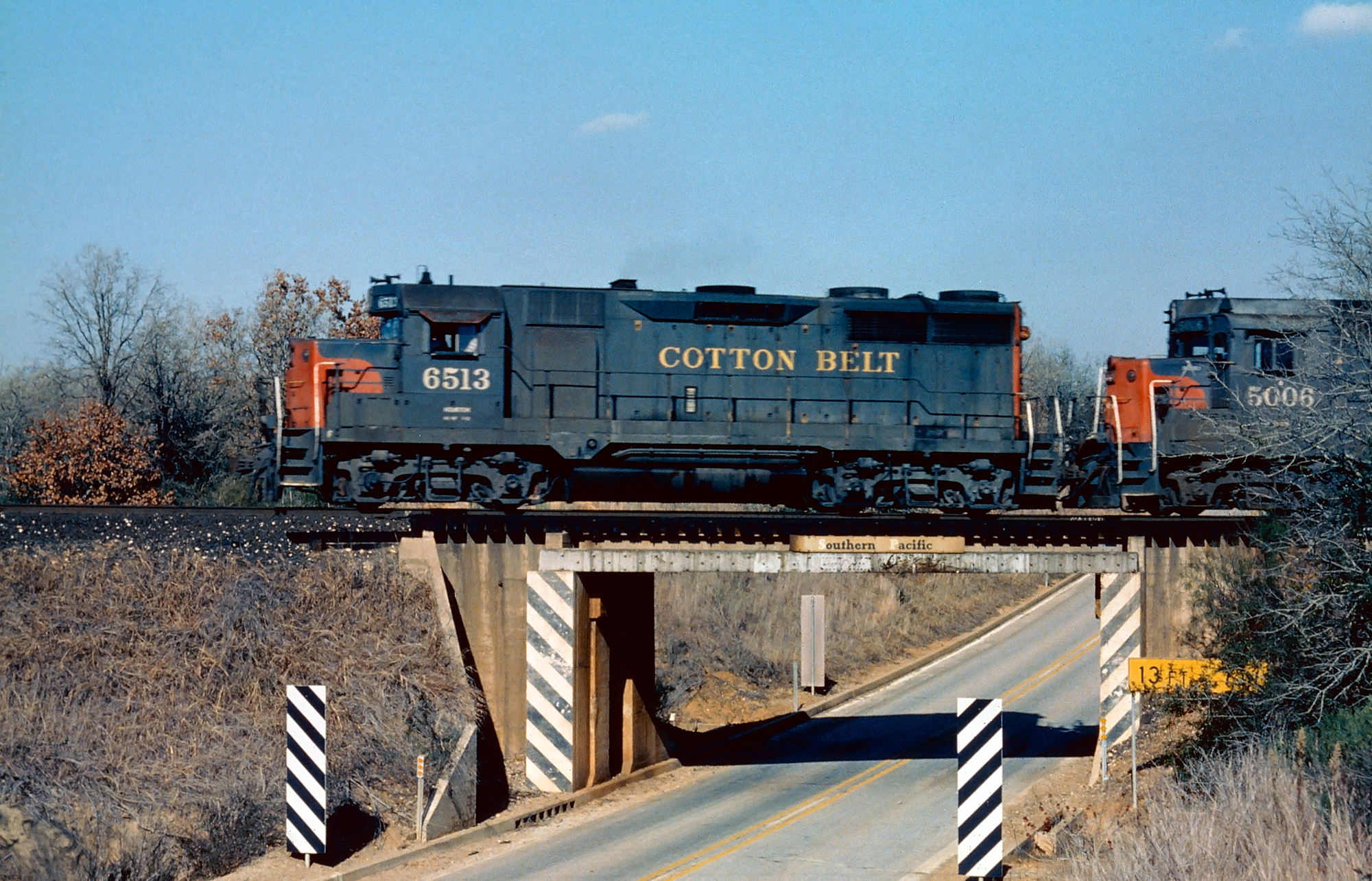 Cotton Belt GP35 #6513 and GP30 #5006 lead a southbound freight over the Route 543 overpass at West Point, Texas on the Southern Pacific, circa 1983. Mike Bledsoe photo. American-Rails.com collection.
Cotton Belt GP35 #6513 and GP30 #5006 lead a southbound freight over the Route 543 overpass at West Point, Texas on the Southern Pacific, circa 1983. Mike Bledsoe photo. American-Rails.com collection.Southern Pacific
Following passage of the Transportation Act of 1920 it returned to private ownership on February 28th. It forever lost its independence on March 11, 1925 when the Chicago, Rock Island & Pacific (Rock Island) gained control. This ownership lasted only briefly as later that year Kansas City Southern picked up Rock Island's interest.
In 1926 the Missouri-Kansas-Texas Railroad (the "Katy") attempted to acquire both the KCS and Cotton Belt to form a respectable Midwestern network but the Interstate Commerce Commission (ICC) would deny the proposal in 1927. Since 1919, the Southern Pacific had held stock in the Cotton Belt, utilizing it as an important St. Louis connection.
It filed an application with the ICC in July of 1930 to acquire control. This was granted two years later and on April 19, 1932 the Cotton Belt formally became an SP subsidiary.
While the St. Louis Southwestern survived as a corporate entity for another sixty years it essentially operated as an arm of the SP, moving every type of freight imaginable.
It grew considerably during its last decade as a separate corporate entity when it was assigned Rock Island's "Golden State Route," purchased by SP in 1981. For years equipment continued to bear "SSW" and "Cotton Belt" markings until the company was dissolved in 1992.
Public Timetables (January, 1930)
Contents
Recent Articles
-
The Wrecking Derrick: Railroading's Unsung Hero
Nov 20, 24 12:35 PM
The wrecking derrick was once a vital piece of maintenance-of-way equipment, ensuring rail lines were quickly reopened following an accident or derailment. -
Buckingham Branch Railroad: Serving Central Virginia
Oct 28, 24 05:17 PM
The Buckingham Branch Railroad is a 275 mile short line that has served Virginia since 1989. -
New York & Long Branch Railroad: An NJ Commuter Line
Oct 26, 24 11:50 PM
The New York & Long Branch Railroad was an historic system running along the northeastern coast of New Jersey and jointly owned by the CNJ and PRR. Today, it is operated by NJ Transit.
